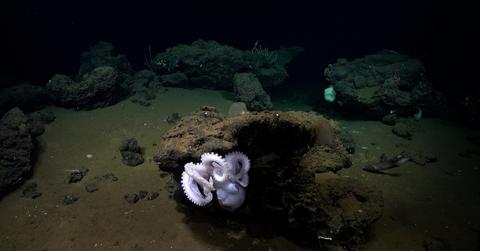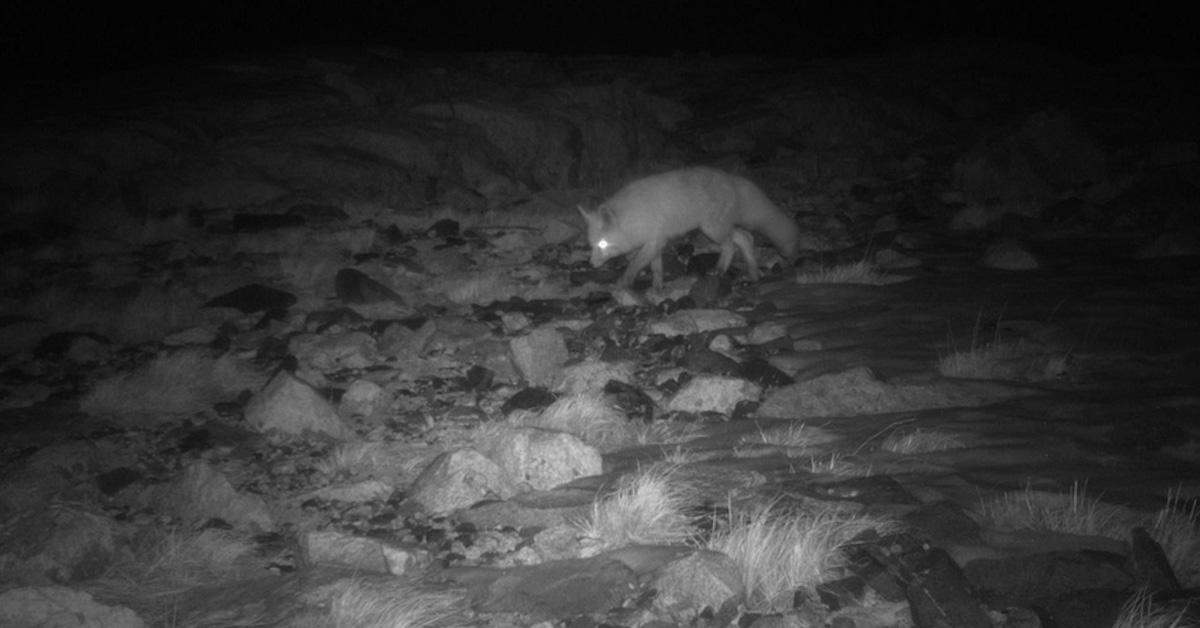The New Animal Species That Have Been Discovered (or Rediscovered) in 2023
Updated Dec. 26 2023, 9:44 a.m. ET

This unidentified octopus is thought to be a new species (verification pending) and was seen at a depth of 3004 meters on an unnamed outcrop southwest of Fuente Seamount in Costa Rican waters as the research team was exploring the area for the first time.
Like every other year in recent history, 2023 has brought the news of numerous species becoming endangered, threatened, and even — gulp — extinct. But on the flip side, this year has also brought about sightings of many new species.
Additionally, experts have miraculously spotted, rediscovered, or recovered a few animal species that haven't been sighted in decades, were thought to be extinct, or were on the brink of extinction. Who doesn't love a sudden and unexpected reappearance?!
Keep reading for a look into some of the new species that have been discovered so far in 2023, with this article having been updated throughout the year.
Five new munidopsid squat lobsters
In January, researchers from Harvard University published a systematic study of East Pacific deep-sea squat lobsters, in which they identified and described five new munidopsid squat lobsters. They are:
- Munidopsis girguisi
- M. nautilus
- M. testuda
- M. cortesi
- M. hendrickxi.
According to the study, munidopsid squat lobsters are one of the most plentiful decapods found at the bottom of the ocean, and there are many subspecies within the species. These five new species of the lobster were discovered in the East Pacific, as part of a group of "many" deep-sea squat lobsters who researchers collected.
The researchers submitted the study on July 1, 2022, and presumably discovered these species sooner than that, but the study was not published until Jan. 11, 2023.
Sierra Nevada red fox

A Sierra Nevada red fox, as captured on camera by the California Department of Fish and Wildlife
In late January, the California Department of Fish and Wildlife (CDFW) announced that its trail cameras helped the agency made four rare sightings of the Sierra Nevada red fox near Taboose Pass, in southern Sierra Nevada, Calif. The species previously hadn't been sighted in nearly a century, and is classified as endangered in California and nationwide.
According to a CDFW press release, this was the first time the Sierra Nevada red fox has been spotted in the area since the 1930s. The cameras technically captured the foxes between April 20 and June 4, 2022, but the agency only shared the news on Jan. 24.
“From a conservation standpoint this shows that the Sierra Nevada Red Fox is more widely distributed than previously believed,” CDFW biologist Brian Hatfield stated.
Kumimanu fordycei and Petradyptes stonehousei penguins
In February, researchers from the University of Cambridge published their discovery of two prehistoric penguin species in the Journal of Paleontology. As noted by The New York Times, the fossilized remains of these two species were found in 57-million-year-old boulders that were recently cracked open by a tide.
The first species is the Kumimanu fordycei, which the researchers believe was the "largest penguin ever to have lived." According to SciTechDaily, the species lived on New Zealand's beaches about 57 million years ago, and each penguin weighed up to about 350 pounds. And as Deseret News noted, the penguins may have measured over 5 feet tall.
The second species is the Petradyptes stonehousei penguin, which the researchers believe weighed about 110 pounds.
Horaglanis populi, a new species of catfish
In January, researchers from India and Germany published a study in the journal Vertebrate Zoology, detailing their discovery of Horaglanis populi, a new species of catfish. The species is "a lineage that is the sister group of all currently known species," and noticeably does not have eyes, and has a long red body, a reduced pectoral fin, and four pairs of barbels.
“This discovery shows that the diversity of subterranean fish species continues to be underestimated and intensive studies are required to understand their true diversity,” lead author Rajeev Raghavan stated, as per Mongabay.
Icaronycteris gunnelli, an extinct bat species
You read that right — this species has been extinct for millions of years, but it was only just discovered.
Two fossils of the bat species in question, the Icaronycteris gunnelli, have been preserved by both the American Museum of Natural History and the Royal Ontario Museum, after originally being found in Wyoming's Green River Formation. And in 2023, researchers decided to take a closer look at the 52 million-year old fossils, and realized that they were part of a previously unidentified species.
"For many years, bat fossils discovered in this formation were assigned to one of two species, depending on their size," Tim Rietbergen, lead author of the study, said in a statement. "We had heard rumors about a smaller bat species being present, but it took a while before such a specimen was brought to our attention."
"If we study other Green River fossils in the world's collections, we might find an even higher bat diversity from this location," he added.
Hericium ophelieae, a new species of medicinal mushroom
In April, Breyten van der Merwe, a student at South Africa's Stellenbosch University — and an avid forager — published his research identifying a new species of medicinal mushroom in the genus Hericium.
He found the species in the Knysna forests, and named it Hericium ophelieae. The name was chosen to honor Arthur Rimbaud's poem "Ophélie."
According to the university, the mushroom is the first endemic species of Hericium to be found in Southern Africa. Previously, this species has been misidentified as Hericium coralloides, aka Coral Tooth mushroom; but van der Merwe used DNA sequencing to identify Hericium ophelieae as a separate species.
“There are likely others to be discovered, as mycology as a discipline is still underdeveloped in Africa and southern Africa," van der Merwe stated. "This finding certainly highlights the need for further research into the fungal diversity of the Afrotemperate forests of South Africa."
Scinax pyroinguinis, a new species of frog with “groins of fire”
In May, researchers in Peru published their discovery of a new species of tree frog, discovered in Peru's Ucayali River.
The frog species, known as Scinax pyroinguinis, is only found in an area "that is currently threatened by habitat loss caused by wildfires," according to the study.
Interestingly, the researchers explain that the name pyroinguinis came from the Greek prefix “pyro” (which means fire) and the Latin word “inguen” (which means groin) — meaning that part of this frog's name literally means "groins of fire." This is so because the frog species discovered has "striking orange blotched groins," which are reminiscent of the "flames of the wildfires threatening its habitat."
You can't make this stuff up.
A potentially new species of the Muusoctopus octopus

This unidentified octopus is thought to be a new species (verification pending) and was seen at a depth of 3004 meters on an unnamed outcrop southwest of Fuente Seamount in Costa Rican waters as the research team was exploring the area for the first time.
In June 2023, scientists from the the Schmidt Ocean Institute announced that they discovered a rare "octopus nursery" in Costa Rica (the third to ever be discovered) — in which there was a “potentially a new species” of the Muusoctopus genus, which refers to a “small to medium sized octopus without an ink sac.”
Researchers actually saw the Muusoctopus species hatch eggs, proving that the octopus nursery is a conducive environment for developing young octopuses. Not to mention, the discovery also provides further proof that certain deep-sea octopus species actually prefer lower temperature habitats for incubating their eggs.
A new species of Peruvian snake called "Tachymenoides harrisonfordi"
On Aug. 15, 2023, scientists from Peru and the U.S. discovered a new species of snake in Peru's Otishi National Park, which they named Tachymenoides harrisonfordi to honor the Star Wars actor for his environmental advocacy. The species is harmless to humans.
Lead scientist and biology professor Edgar Lehr said to Conservation International, "Only organisms that are known can be protected." This is not the first time a creature has been named for Ford — he also has a Californian spider and an ant to his name!
De Winton’s golden mole
In early December, South Africa-based scientists published a paper, announcing that they rediscovered a "lost" species called De Winton’s golden mole, aka Cryptochloris wintoni. This was done thanks to a combination of environmental DNA (eDNA) sampling and a dog trained in detecting scents.
As reported by Smithsonian Magazine, the last time someone observed a De Winton’s golden mole was in in 1936. For that reason, the species has been listed as both "critically endangered" and" possibly extinct." Now, we know that this species — one of 21 golden mole species on Earth — is not extinct.
Saiga antelope
On Dec. 12, 2023, the University of Oxford reported that the Saiga antelope, which has long been on the brink of extinction, had made a miraculous recovery. Thanks to the conservation efforts made to protect the Saiga antelope in Kazakhstan over the past few decades, the species' official Red List classification has changed from Critically Endangered to Near Threatened.
As noted by Oxford, Saiga antelopes got a spotlight in 2023, thanks to being featured on Sir David Attenborough's show Planet Earth III. On the show, Attenborough called Saigas "Small but tough animals that lived alongside woolly mammoths."
Five new species of soft furred hedgehogs
A group of international researchers, led by scientists working for the Smithsonian, published a study in the Zoological Journal of the Linnean Society on Dec. 21, 2023, to identify five new species of soft furred hedgehogs. The little hedgehogs are known as "lesser gymnures" or "Hylomys" and are native to Southeast Asia.
Previously, there were only two known species of the group — now there are seven!
This article, originally published on Jan. 27, 2023, has been updated to include more species.